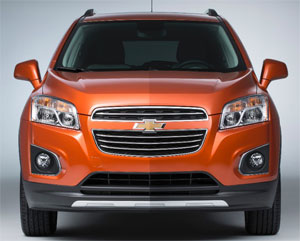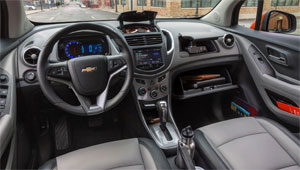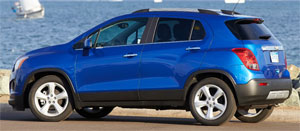2015 Chevrolet Trax
Chevrolet is well known for its full-size SUVs like this Tahoe. But, it’s really small utes that are fast becoming today’s big deal. The Nissan Juke, MINI Countryman, and Buick Encore are already out, with more coming like the Honda HR-V, Jeep Renegade, and our focus this week, the Chevrolet Trax. Now, Chevy is no stranger to tiny utes. But, their last one, the Tracker built with Suzuki, was less than the best. So let’s see the new Trax is on the right track.
Utility vehicles are coming in ever more shapes and sizes these days, so love them or hate them; they’re not going away anytime soon. This 2015 Chevrolet Trax plays into a segment that is ripe for explosive growth: sub-compact crossovers.
While most efforts so far have been luxury minded, like the Mini Cooper Countryman, and Buick Encore, with which this Trax shares a platform, more mainstream brands are now joining the downsizing. And it’s about time, as we think the Encore’s size would work for Chevy from the get go.
 And actually it has been, as the South Korean made Trax is already sold in over 60 global markets. It’s just new to Chevy dealers here.
And actually it has been, as the South Korean made Trax is already sold in over 60 global markets. It’s just new to Chevy dealers here.
Mechanically, the Trax is nearly a clone of the Encore, including front-wheel-drive being standard with all-wheel-drive optional. Power comes from the same “little engine that almost can”. Lifted from the Chevy Sonic subcompact, it’s a 1.4-liter I4 turbo with 138-horsepower and 148 lb-ft. of torque, attached to a 6-speed automatic transmission. Also from Sonic is the MacPherson strut front suspension, and compound crank torsion beam under the rear.
On both city streets and the sweeping canyons east of San Diego, where we got our first drive, the suspension tuning proved fully competent; similar to Encore; not sporty, not soft, but a good middle ground. Ride quality is pretty good for a short wheelbase vehicle, until the roads get really choppy.
The all-wheel-drive system is a fully automatic on-demand system. Sending power rearward when slip is detected, which does include on tight turns. Curb weight is as much as 3,300 pounds with all-wheel-drive.
On the technology front, the Trax is fully up to speed with a 7-inch MyLink display in the center stack, Siri Eyes Free connectivity, standard keyless entry; and optional remote start. Like all newest GM’s, OnStar 4G LTE with built-in WiFi is standard, as is a back-up camera; though navigation, by way of the BringGo app is optional.
 The instrument panel is more Sonic than Encore with a large, round, motorcycle style tachometer on the left, and a rectangular digital display right for speed and more. The 3-spoke steering wheel has nicely integrated controls; and the overall fit-and-finish of the interior seems perfectly fine for a Chevy price point.
The instrument panel is more Sonic than Encore with a large, round, motorcycle style tachometer on the left, and a rectangular digital display right for speed and more. The 3-spoke steering wheel has nicely integrated controls; and the overall fit-and-finish of the interior seems perfectly fine for a Chevy price point.
A full complement of 3 in the back seat would be uncomfortable for all parties involved, but both leg and knee room were adequate for 2 adults; reliefs cut into the front seatbacks help a lot. Up front, there’s a good amount of room as well, but seats are narrow and you still sit very upright.
As for cargo, rear seatbacks fold 60/40, and the front passenger seat folds flat as well, for longer items. At 18.7 cubic-ft., rear cargo space is larger than both the Nissan Juke and Jeep Renegade, 48.4 cubic-ft. with the seat backs folded.
And there’s a wealth of small item storage bins throughout the interior. 10-airbags are standard, including rear seat-mounted thorax bags.
On the outside, all of the current Chevrolet design cues are here; dual-port grille, smooth body sides with rounded fenders, and a gently sloping rear with well integrated spoiler that extends down the sides of the back glass, and stacked tail lamps.
 It’s a smooth design with plenty of curves, a fairly aggressive stance, and enough glass for fine visibility. Body lowers are covered in plastic; and simulated skid plate’s front and rear hint at capabilities that are probably best left untested.
It’s a smooth design with plenty of curves, a fairly aggressive stance, and enough glass for fine visibility. Body lowers are covered in plastic; and simulated skid plate’s front and rear hint at capabilities that are probably best left untested.
16-inch wheels are standard, with the top trim model getting 18’s. Wheelbase of just 100.6-inches, and a front track of 60.6 inches makes for a tidy package. Overall length comes in at 168.5-inches; ground clearance is a good 6.2-inches.
Government Fuel Economy Ratings for a front-wheel-drive Trax are 26-City, 34-Highway, and 29-Combined. Sending power to all 4 wheels will lower those numbers to 24-city, 31-Highway, and 27-Combined. That’s still good for an above average Energy Impact Score of 11.4-barrels of annual oil use with CO2 emissions of 5.1-tons.
Pricing follows an affordable Chevrolet formula starting at $20,995. All-wheel-drive adds $1,500 more, which makes it the least expensive all-wheel-drive Chevrolet you can buy. A base Encore stickers for 4-grand more.
So for 2015, GM morphs the Buick Encore into the Chevrolet Trax, and fortunately all of the competency is left fully intact. The Encore was a much bigger hit than expected, so this one will certainly have higher expectations. But, we think the Trax is off on the right track to fully meet them.
Specifications
- Engine: 1.4 liter
- Horsepower: 138
- Torque: 148 lb-ft.
- EPA: 26 mpg city/ 34 mpg highway
- Energy Impact: 11.4 barrels of oil/yr
- CO2 Emissions: 5.1 tons/yr
2024 Polestar 2
More Range And More Power For The Polestar 2
Volvo is well on their way to making the transition to an all-electric brand, but their sister-brand Polestar is already there. Now, we’ve spent lots of time in their all-wheel drive, five-door Polestar 2, having tested it in 2021, and a year later when a two-wheel drive version arrived. But, EV updates are coming quickly. So, let us be your guide for all that’s new with the Polestar 2.
While we are driving more EVs than ever, we’ve also been spending a lot of time recently circling back to ones we’ve previously tested. As in this new era of electrified vehicles, significant updates are arriving quickly, with R&D investments increasing and retrofitting them easier than ever. This is often done through software updates that can even be accomplished over the air. For 2024, the Polestar 2 has indeed gotten some software updates, but some physical ones as well.
Clearly aimed directly at Tesla’s Model 3 when it arrived; the Polestar 2’s build quality was vastly better, but range definitely came up short. So, addressing that was priority No. 1; and for ’24 the Polestar can travel up to 20% farther than before while consuming 9% less energy, and when it comes time to charge it back up, it can do that 34% faster too.
Range in the Single Motor version increases from a max of 270 to 320 miles thanks to a larger 82-kWh battery pack, and that solitary motor now powers the rear wheels, not the front wheels. It’s also bigger, coming in at 220 kW compared to the previous 170 kW front-wheel drive version, going from 231 to 299 horsepower.
Dual Motors keep the same 78-kWh battery, but still sees a boost from 260 to 276 miles and takes advantage of the larger rear motor for a new combined 310-kW output with 421 horsepower. Our test car has the added Performance Pack, which uses an additional 35 kW to deliver 455 horsepower and 546 lb-ft of torque, though max range drops to just 247 miles.
The new battery in rear-drive 2s will also charge faster, now accepting up to 205 kW for an 80% charge in 20 minutes; max for dual-motors stays at 155 kW, which puts an 80% charge at 34 minutes. Using 32 kWh of electricity per 100 miles, the Dual Motor earns a good efficiency rating.
The [Polestar] 2 has always been one of the most enjoyable EVs to drive, even more so now with that additional power coming from the rear motor.
Unfortunately, extremely cold temperatures kept us from seeing that increased range, as we were only on pace for about 194 miles in our test.
The 2 has always been one of the most enjoyable EVs to drive, even more so now with that additional power coming from the rear motor. And especially when equipped with the Performance Pack as it not only includes more power, but adds 20-inch forged wheels, upgraded brakes, and adjustable Ohlins Dual Flow Valve performance dampers. It greatly improves handling prowess without affecting ride quality, and is easily worth the $5,500 charge if you at all enjoy driving.
Even on a 20-degree track day there was plenty of grip through our handling course. No understeer or oversteer, and lots of feedback through the wheel. There was a nice, strong launch off the line that properly planted us firmly in the seat, and rocketed us to 60 in 4.5 seconds. Power delivery stayed pretty intense up until about 80 mph when there was a definite tapering off. Still, it was a 13.4-second quarter-mile at 102 mph; smooth, quiet, and stable the whole way.
When this car debuted, its Google-based infotainment setup was a novelty, but since then, more and more manufacturers are just “Googling it” so it doesn’t seem out of place at all. The wireless phone charger is easy to access, and there’s a great Harmon/Kardon sound system and panoramic sunroof to enhance the in-cabin experience. Exteriors have also been enhanced with a smooth grille insert and new wheel choices.
Hatchback practicality means 14.3 cu-ft of easy to access cargo space with split-folding seatbacks for longer items and expanding the space to 38.7 cu-ft. Plus, there’s even a sizeable storage bin up front under the hood.
Single Motor Polestar 2 pricing now starts at $51,300, with Dual Motors starting at $56,700; topping out at $64,400.
For a car manufacturer that hasn’t even been around for a decade yet, Polestar has kept itself busy, totally transforming their latest model in just a few years, making the 2024 Polestar 2 even more appealing. They are certainly off to a good start, and with a host of Polestars just over the horizon, including some all-important utility vehicles, this star will be shining even brighter.
Specifications
As Tested
- Motor Setup: Dual Motor
- Horsepower: 455
- 0-60 mph: 4.5 seconds
- EPA Range: 247 miles
- Efficiency : 32 kWh / 100 miles
- Battery Size: 78-kWh
- Torque: 546 lb-ft
- 1/4 Mile: 13.4 seconds at 102 mph
- MW Test Loop: ~ 194 miles
- Peak Charging Rate: 155 kW











































